Seagate and Western Digital 1TB Drives: Improved and Green
by Dave Robinet on November 26, 2007 7:00 AM EST- Posted in
- Storage
PCMark Vantage Continued...
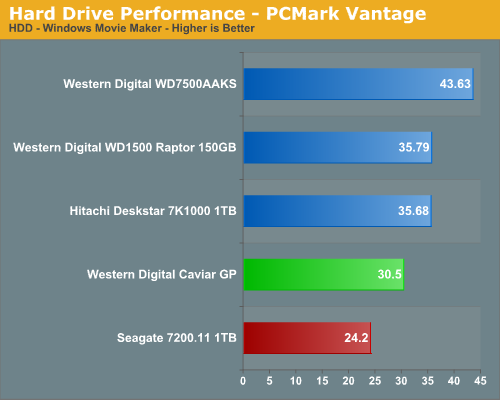
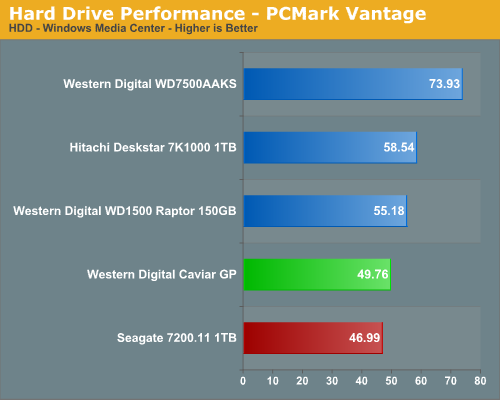
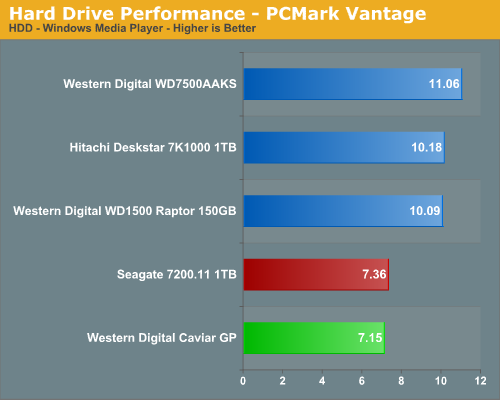
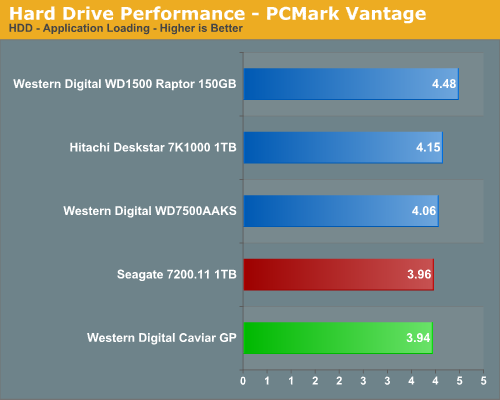
Remaining true to what we've come to expect in our previous tests, PCMark Vantage shows us that neither the WD Caviar GP nor the Seagate 7200.11 are performance leaders. While the results they turn in are respectable, they are no threat to the drives sitting atop our charts.
Of interest, the Seagate performed poorly in both benchmarks that had higher write operation content. We have re-run the tests several times, and continue to see the Seagate 7200.11 drive turn in sub-par results in these types of tests. We saw this trend continue not only in PCMark Vantage, but also throughout the entire test suite for this article. The results indicate that the write performance problems with the 7200.10 are still present with this series update.
Vista Startup / Shutdown
As in our Windows XP test, we feel it is important to include Windows Vista startup and shutdown figures. Given the amount of suspend-related problems that Microsoft is still working out with Vista, we will exclude hibernation and resume scores from our current test methodology. We will re-evaluate this after Service Pack 1 is available for general use.
Our startup timer begins when we select Vista from the OS Choices menu at startup. We end when the login screen appears. For the shutdown test, we turn off Vista with no applications running. We run the test three times, and take the average result of the three scores.

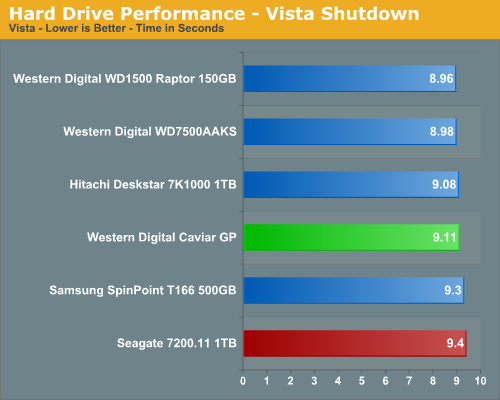
The Western Digital GP is clearly slower than any other drive in the startup tests while it performs better in the shutdown test. The Seagate 7200.11 has results again at the bottom of this elite pack of drives, but with better performance than the WD drive in the startup test and lower performance in the shutdown test.










31 Comments
View All Comments
retrospooty - Monday, November 26, 2007 - link
I for one found the article helpful. It isn't about showing performance and choosing a winner based on speed, it is about showing all aspects of each and letting the buyer decide. Some people might want pure speed, and some might want a low power, quieter option.I think logic is lost on some people.
gmyx - Monday, November 26, 2007 - link
While 4w may not seem like much to a power user, it is a big deal to someone who is building a low power system such as a VIA based system. It's obviously not going to be used for playing games but can certainly work as a file server / internet proxy. When you can get a power supply with a total output of 60w (pico 60w power supply) every watt saved brings your total lower. A lower total mean less cost for your file server / internet proxy.Lonyo - Tuesday, November 27, 2007 - link
I would imagine it would also be nice for a low power home file server.1 of these 1TB drives would use probably <1/3rd of the power of 2x500GB drives, or ~1/2 the power of another 1TB drive.
If you have say a RAID-5 array with 5 or 6 of these drives, you're looking at a decent reduction in power which is always nice for a 24/7 machine.
Googer - Monday, November 26, 2007 - link
Those who have wanted to use low power hard drives on a desktop motherboard have always had the option of using 2.5" laptop drives.Dave Robinet - Monday, November 26, 2007 - link
Well put, Jarred.The Hitachi was reviewed some time ago, now, and (as you mention) its results are included in the charts. It gets mention in the conclusion as being the preferred option over the Seagate, as well.
The Green drive does have a place as a quiet drive (the quietest of the 1TB drives tested), and it comes at a low price point. That's considerable - particularly for HTPC users, who may not appreciate the Hitachi's noise.
For performance-oriented applications, though, it's a tough sell.
DigitalFreak - Monday, November 26, 2007 - link
Me thinks that this whole "green" thing from WD is because they were having issues producing a performance drive. Maybe the lower power consumption would make sense in a laptop drive, but I'd much rather have performance on the desktop.Seagate's ATA drives have always been so-so performers, so I'm not surprised with the outcome. However, they 5 year warranty more than makes up for it in a home server environment.
jojo4u - Monday, November 26, 2007 - link
Other drives are performing well. It's nice to have the choice. And there are uses for low-power high-capacity drives.jojo4u - Monday, November 26, 2007 - link
See page 2 and page 3 http://www.storagereview.com/1000.sr?page=0%2C2">http://www.storagereview.com/1000.sr?page=0%2C2Your low-level results also back this up.
DigitalFreak - Monday, November 26, 2007 - link
There was a discussion on their forums about how it would be prohibitively expensive to produce a drive that could vary it's spindle speed due to the extra stress on the mechanism.Interlink - Tuesday, November 27, 2007 - link
Anybody with a mic e.g. in his headset and a PC with microphon input is able to measure the fixed spindle speed of a WD10EACS: [url=http://forums.storagereview.net/index.php?showtopi...">http://forums.storagereview.net/index.p...c=26021&...]5400 rpm[/url].